Testing Composite Valve Covers for Reciprocating Engine Applications
- 1 School of Aviation and Transportation Technology, Purdue University, United States
Abstract
The use of composites within the aeronautical field is not limited to airframe applications and includes powerplant components in reciprocating engines. To add to the research body in this area, the presented work aimed to evaluate the performance of novel carbon fiber valve covers installed on an aircraft reciprocating engine. Specifically, the comparative performance between novel composite-based valve covers and original steel valve covers was of interest, with a focus on the thermal and cooling behavior. The experimental procedure simulated certification testing required for parts manufacturer approval provided by the Federal Aviation Administration and followed the cooling test protocol outlined by ASTM International. The test engine was run once with each valve cover type and at multiple power settings, throughout which the surface temperature of the valve covers was recorded. In addition, the carbon fiber valve cover was subjected to a post-run visual inspection to identify the overall condition thereof and any potential damage introduced under engine operating conditions. The experimental study revealed lower temperatures with accompanying higher cooling and heating rates for the carbon fiber valve cover when compared to the original steel valve cover. Moreover, sealing issues on the carbon fiber valve cover were observed. The high heating rates coupled with the sealing issues can have a detrimental impact on the engine operation and lifetime, thus, equivalency requirements were not met. While the novel carbon fiber valve cover did not perform at directly equivalent levels to the original steel valve cover, the potential for future improved performance is demonstrated. Especially the lower temperatures sustained, the rapid cooling rate, and the weight savings associated with the use of composite materials are promising. Moreover, the results obtained can be used to further refine the design of composite-based valve covers, with the ultimate goal of meeting certification and applicational requirements.
DOI: https://doi.org/10.3844/ajeassp.2022.178.188

- 4,272 Views
- 2,400 Downloads
- 0 Citations
Download
Keywords
- Composites
- Carbon Fiber
- Reciprocating Engines
- FAA Certification
- Testing
